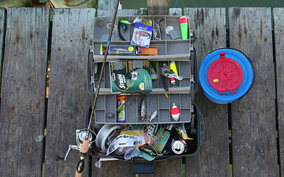
No fishing expedition is complete without the all-important tackle box. This is your security safe which houses everything you need to successfully fish. Experienced anglers don't need to be told what to carry but beginners sure do. So if you're planning your first ever fishing trip, the tackle box should be the main thing to organize.
You can always purchase a complete kit at a store but most fishermen prefer to select tools separately. Make and model are personal preferences and the basics is what you should concentrate on.
Bobbers
Bobbers or fishing floats are buoyant devices that float on water and sink when a fish takes the bait. Not everyone uses them but doing so allows you more freedom to turn attention away during fishing. Once the bobbers start to sink, you know it's time to start reeling in the catch.
A bobber is a type of bite indicator and you can choose electronic bite alarms or quiver tips instead. The choice is up to you.
Sinkers
Sinkers are weights attached to a fishing rig to allow it to sink deeply. They're readily available and most are made of steel and tungsten. Take along several sinkers as they can easily get lost.
Needle nose pliers and scissors
Hooks and lines are tough and difficult to cut. The two tools here will allow you to remove them effortlessly.
Bait and lure
Bait can be either artificial or live. The choice is up to you. However, if you do go with live bait, carry along some artificial ones as well (known as lures). You never know when you might run out. Besides, if handling worms is not up your alley, lures are the only solution.
Incidentally, many confuse bait and lure. The most basic difference is that bait refers to food which can be digested by fish. Lures are artificial and modeled to look like bait.
Hooks
Extra hooks should also be included in a tackle box. Like other tools, there are several types of hooks and which to choose boils down to personal preference. What cannot be attributed to preference is size. Large hooks should only be used for large fish and small ones for small fish. Interchanging them will result in tearing flesh or giving a large fish a chance to escape.
Lines
Like hooks, always carry extra lines. As durable as they are, they break for any number of reasons. You'll also want to carry different types of lines if you aren't sure where you'll be fishing. For example, heavy lines are suitable for rough conditions and thin, clear lines for fishing in clear waters.
Scales
Weighing scales help measure the weight of your catch. They're not as important as the rest of the tools but will help you accurately gauge just how large a catch you've landed.
Spincast reel
Experienced fishermen don't use them but spincast reels are best for beginners. If you feel you're ready to mature in fishing then by all means go for a baitcaster or a spinning reel.
Sunscreen
You'll be spending long hours under the sun as the best time to fish is in the afternoons and early evenings. Water reflects more light too so skin burns faster. Arm yourself with a good sunscreen having a SPF of 50 or 75.
First aid kit
This goes without saying so pack up a few essential first aid items.
Fishing lures provide many benefits and they are less messy than bait. They are equipped with one or more hooks that are used to hook fish when they attack the lure. Refer this link for additional details.
Article Source: http://EzineArticles.com/?expert=Melissa_Mao
http://EzineArticles.com/?Have-These-Essential-Fishing-Gear-In-Your-Tackle-Box&id=7814412

